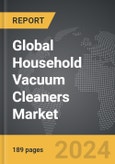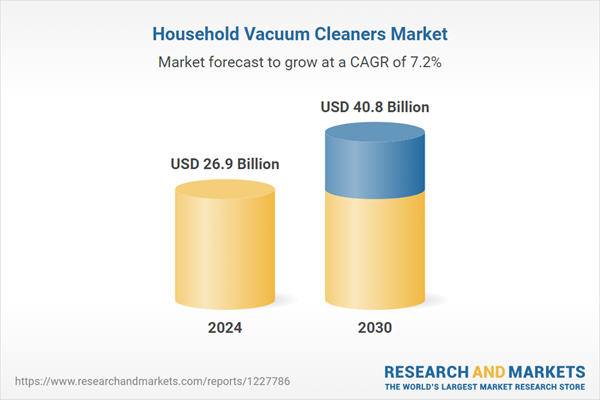Household Vacuum Cleaners - Key Trends and Drivers
Household vacuum cleaners are essential appliances designed to maintain cleanliness and hygiene in homes by removing dust, dirt, and debris from floors and other surfaces. These devices have evolved significantly since their inception, incorporating advanced technologies to enhance performance, convenience, and efficiency. Modern vacuum cleaners come in various types, including upright, canister, stick, robotic, and handheld models, each catering to different cleaning needs and preferences. Upright vacuum cleaners are popular for their powerful suction and ease of use on carpets, while canister vacuums offer greater flexibility and maneuverability, making them suitable for a variety of floor types and hard-to-reach areas. Stick and handheld vacuums are valued for their lightweight and cordless design, providing quick and convenient cleaning solutions. Robotic vacuum cleaners, equipped with sensors and smart technology, have revolutionized the market by offering autonomous cleaning capabilities, allowing users to maintain clean floors with minimal effort.Technological advancements have played a crucial role in the evolution of household vacuum cleaners. Innovations such as HEPA (High-Efficiency Particulate Air) filters, bagless designs, and cyclonic suction have significantly improved the efficiency and user-friendliness of these appliances. HEPA filters capture fine particles and allergens, enhancing indoor air quality, which is particularly beneficial for allergy sufferers. Bagless vacuums eliminate the need for replacement bags, reducing maintenance costs and environmental impact. Cyclonic suction technology ensures consistent and powerful performance by preventing clogging and maintaining airflow. Furthermore, the integration of smart technology and IoT (Internet of Things) has introduced features like programmable cleaning schedules, remote control via smartphone apps, and voice command compatibility with virtual assistants such as Amazon Alexa and Google Assistant. These advancements have made vacuum cleaners more versatile and convenient, catering to the evolving needs and preferences of consumers.
The growth in the household vacuum cleaners market is driven by several factors, including rising consumer awareness about hygiene, increasing disposable incomes, and the growing trend towards smart homes. The heightened emphasis on cleanliness, especially in light of the COVID-19 pandemic, has spurred demand for efficient and reliable cleaning solutions. Technological innovations, such as robotic vacuums and smart features, are attracting tech-savvy consumers looking for convenience and automation in their household chores. The expanding middle class in emerging economies, coupled with increasing disposable incomes, is boosting the adoption of advanced vacuum cleaners. Additionally, the trend towards urbanization and smaller living spaces is driving demand for compact and efficient cleaning appliances. Environmental concerns and the preference for sustainable products are also influencing market trends, with consumers gravitating towards energy-efficient and eco-friendly vacuum cleaners. Overall, the household vacuum cleaners market is poised for continued growth, driven by technological advancements, changing consumer lifestyles, and the increasing focus on maintaining clean and healthy living environments.
Report Scope
The report analyzes the Household Vacuum Cleaners market, presented in terms of market value. The analysis covers the key segments and geographic regions outlined below.- Segments: Type (Upright, Canister, Robotic, Drum, Wet / Dry, Central, Other Types); Mode of Sale (Offline, Online).
- Geographic Regions/Countries: World; United States; Canada; Japan; China; Europe (France; Germany; Italy; United Kingdom; Spain; Russia; and Rest of Europe); Asia-Pacific (Australia; India; South Korea; and Rest of Asia-Pacific); Latin America (Argentina; Brazil; Mexico; and Rest of Latin America); Middle East (Iran; Israel; Saudi Arabia; United Arab Emirates; and Rest of Middle East); and Africa.
Key Insights:
- Market Growth: Understand the significant growth trajectory of the Upright Vacuum Cleaners segment, which is expected to reach US$12.0 Billion by 2030 with a CAGR of a 7.5%. The Canister Vacuum Cleaners segment is also set to grow at 7.7% CAGR over the analysis period.
- Regional Analysis: Gain insights into the U.S. market, valued at $6.9 Billion in 2024, and China, forecasted to grow at an impressive 10.9% CAGR to reach $9.9 Billion by 2030. Discover growth trends in other key regions, including Japan, Canada, Germany, and the Asia-Pacific.
Why You Should Buy This Report:
- Detailed Market Analysis: Access a thorough analysis of the Global Household Vacuum Cleaners Market, covering all major geographic regions and market segments.
- Competitive Insights: Get an overview of the competitive landscape, including the market presence of major players across different geographies.
- Future Trends and Drivers: Understand the key trends and drivers shaping the future of the Global Household Vacuum Cleaners Market.
- Actionable Insights: Benefit from actionable insights that can help you identify new revenue opportunities and make strategic business decisions.
Key Questions Answered:
- How is the Global Household Vacuum Cleaners Market expected to evolve by 2030?
- What are the main drivers and restraints affecting the market?
- Which market segments will grow the most over the forecast period?
- How will market shares for different regions and segments change by 2030?
- Who are the leading players in the market, and what are their prospects?
Report Features:
- Comprehensive Market Data: Independent analysis of annual sales and market forecasts in US$ Million from 2024 to 2030.
- In-Depth Regional Analysis: Detailed insights into key markets, including the U.S., China, Japan, Canada, Europe, Asia-Pacific, Latin America, Middle East, and Africa.
- Company Profiles: Coverage of players such as Atkins Nutritionals Inc., Britvic Plc, Brothers International Food Corp., Campbell Soup Company, Conagra Brands Inc. and more.
- Complimentary Updates: Receive free report updates for one year to keep you informed of the latest market developments.
Some of the 33 companies featured in this Household Vacuum Cleaners market report include:
- AB Electrolux
- BISSELL
- Dongbu Daewoo Electronics Corporation
- Dyson Ltd.
- Groupe SEB
- Haier Group
- Hitachi Appliances Inc.
- iRobot Corporation
- Koninklijke Philips NV
- LG Electronics
- Midea Group
- Morphy Richards
- Neato Robotics
- Panasonic Corp.
- Samsung Electronics Co., Ltd.
- Stanley Black & Decker Inc.
- Techtronic Industries Co Ltd.
- TTI Floor Care North America
- Vax Ltd.
This edition integrates the latest global trade and economic shifts into comprehensive market analysis. Key updates include:
- Tariff and Trade Impact: Insights into global tariff negotiations across 180+ countries, with analysis of supply chain turbulence, sourcing disruptions, and geographic realignment. Special focus on 2025 as a pivotal year for trade tensions, including updated perspectives on the Trump-era tariffs.
- Adjusted Forecasts and Analytics: Revised global and regional market forecasts through 2030, incorporating tariff effects, economic uncertainty, and structural changes in globalization. Includes historical analysis from 2015 to 2023.
- Strategic Market Dynamics: Evaluation of revised market prospects, regional outlooks, and key economic indicators such as population and urbanization trends.
- Innovation & Technology Trends: Latest developments in product and process innovation, emerging technologies, and key industry drivers shaping the competitive landscape.
- Competitive Intelligence: Updated global market share estimates for 2025, competitive positioning of major players (Strong/Active/Niche/Trivial), and refined focus on leading global brands and core players.
- Expert Insight & Commentary: Strategic analysis from economists, trade experts, and domain specialists to contextualize market shifts and identify emerging opportunities.
Table of Contents
Companies Mentioned (Partial List)
A selection of companies mentioned in this report includes, but is not limited to:
- AB Electrolux
- BISSELL
- Dongbu Daewoo Electronics Corporation
- Dyson Ltd.
- Groupe SEB
- Haier Group
- Hitachi Appliances Inc.
- iRobot Corporation
- Koninklijke Philips NV
- LG Electronics
- Midea Group
- Morphy Richards
- Neato Robotics
- Panasonic Corp.
- Samsung Electronics Co., Ltd.
- Stanley Black & Decker Inc.
- Techtronic Industries Co Ltd.
- TTI Floor Care North America
- Vax Ltd.
Table Information
| Report Attribute | Details |
|---|---|
| No. of Pages | 189 |
| Published | December 2025 |
| Forecast Period | 2024 - 2030 |
| Estimated Market Value ( USD | $ 26.9 Billion |
| Forecasted Market Value ( USD | $ 40.8 Billion |
| Compound Annual Growth Rate | 7.2% |
| Regions Covered | Global |









